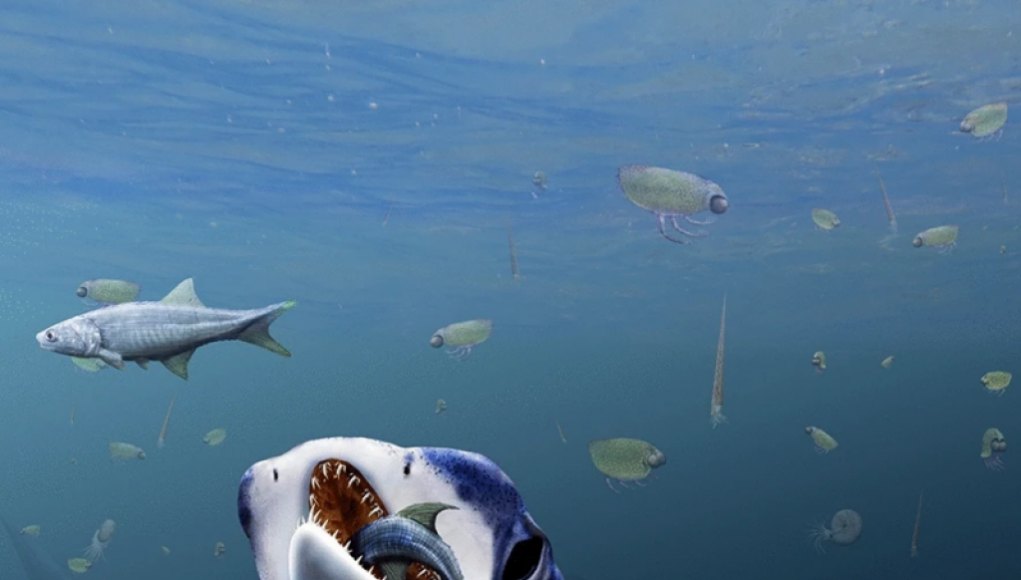Prepare to be amazed! Scientists have made an incredible discovery – a brand new species of shark from the Late Devonian period. This period was a time of rapid growth for sharks, and these ancient creatures were just starting to dominate the ancient oceans.
What makes this discovery even more remarkable is that the fossils found are incredibly well-preserved. They include soft tissues like scales, muscles, digestive tracts, livers, and even imprints of blood vessels. But the most fascinating feature of this new species is its widely separated nasal organs, similar to those found on today’s hammerhead sharks. It seems that even back then, sharks were already developing their incredible sense of smell.
A fascinating time and a rare find
The lead author of the study, Christian Klug, explains the significance of the Devonian period. It was a time of intense competition among predators in the water, leading to the evolution of more efficient organisms. This affected their swimming abilities, feeding apparatus, and even their sensory systems. Sharks had to adapt to detect prey, navigate their surroundings, and escape from larger predators like the fearsome Dunkleosteus and Ctenacanthus.
Speaking of Dunkleosteus, this armored fish was one of the most terrifying creatures of the Devonian. With its razor-sharp fangs and deadly bite force, it was a force to be reckoned with.
The new shark fossils were discovered in the Maïder and Tafilalt regions of Morocco, known for their rich fossil deposits. These areas are a haven for fossil collectors, with an abundance of ammonoids, trilobites, brachiopods, fishes, corals, and trace fossils. The region is truly a “cephalopod paradise.”
Advertisement
Unlike other fish fossils from this time, the fossils found at this site were not flattened by millions of years of geologic pressure. They provide a unique glimpse into the past, allowing scientists to study the ancient ecosystem in three dimensions.
The new shark species has been named Maghriboselache mohamezanei, in honor of the country where it was found and one of the people responsible for its discovery. The fossils have revealed an unexpected feature – widely spaced nasal capsules. This is a rare characteristic not seen in other contemporary or subsequent Palaeozoic sharks and may even be the earliest instance in all jawed vertebrates.
The incredible sense of smell
Most sharks have closely spaced nasal capsules, except for the hammerhead shark, which has them widely apart. This unique feature allows hammerheads to pinpoint odors with more precision and determine the direction of a smell. The team suggests that Maghriboselache may have had a similar ability, even if its nasal capsules were not as far apart as those of modern hammerheads.
This discovery opens up new questions about the form and function of ancient sharks. Aubrey Clark, a sensory biologist, explains that fossils provide insights into the physical structure of organisms, but understanding their function is a whole different challenge.
Scientists have made a surprising new discovery about the sense of smell of long-extinct sharks. Using 3D optical imaging, researchers at the University of South Florida have uncovered the fact that one species of shark had the ability to detect and differentiate smells in a way similar, if not superior, to modern sharks—a remarkable feat given how long this species has been extinct.
Based upon the fossilized remains of a 300-million-year-old shark called the Doliodus, the research team found evidence of two olfactory sensors in the upper jaw, which would have allowed the shark to smell in “stereo”. This would have been an incredibly sophisticated sense of smell, which assisted the shark in finding food and detecting danger in dark, murky waters.
The discovery has been described as “groundbreaking” by the scientists involved. It demonstrates that ancient species of shark possessed the same sensory capabilities as their modern counterparts, contrary to previous beliefs. It also indicated a previously unknown level of complexity in the evolution of shark senses.
The study also indicates that some ancient species may have been more advanced in certain areas than those alive today. “The biggest surprise is the incredible level of detail that can be gleaned from three-dimensional fossils” said Dr. John Maisey, one of the researchers. “It opens up exciting possibilities for us to explore the senses of prehistoric fish in a whole new light.”
The discovery will no doubt offer researchers a better understanding of the evolution of sense organs in sharks, and may provide key insights into the evolution of other species as well. The findings were published in the journal Nature.




















